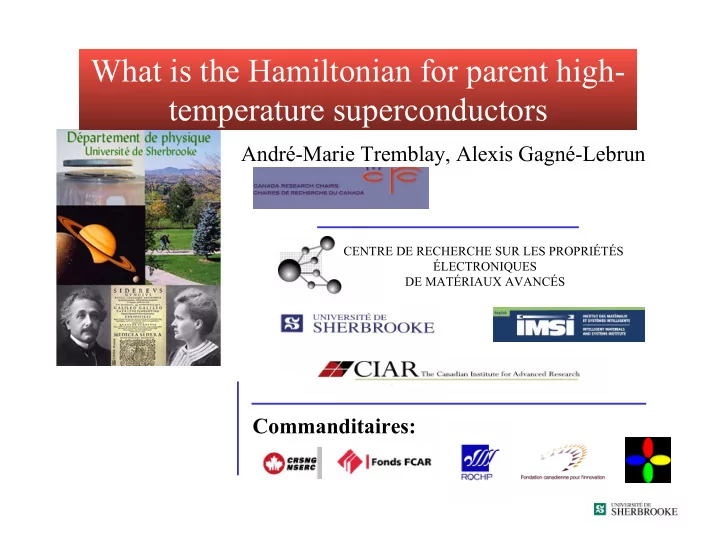

What is the Hamiltonian for parent high- temperature superconductors André-Marie Tremblay, Alexis Gagné-Lebrun CENTRE DE RECHERCHE SUR LES PROPRIÉTÉS ÉLECTRONIQUES DE MATÉRIAUX AVANCÉS Commanditaires:
Outline • What is the problem? • What is the numerical method? • What are the results? • Conclusion
What is the problem ? Materials and theoretical considerations Experiments Previous theoretical work
What is the problem?
Hole concentration (doping δ) Antiferromagnet
Residual interactions must be added to band structure The simplest model for Cu O 2 planes. µ U t 4 N •Size of Hilbert space : (N = 16) •With N=16, need 4 GigaBits just for states
Hubbard model (Kanamori, Gutzwiller, 1963) : ³ ´ X c j c j c i X H ij t i , j c i † † U i n i n i H = − j¾ + c + U t c ¾ c j¾ c n i ↑ n i ↓ i ; j i ¾ i < i j> ¾ i - « Screened » interaction U - U, T smallest, n = 1 (ou δ =1-n) - a = 1, t = 1, h = 1 U t Strong vs weak coupling T U ~ 8t • t from band structure, Strong coupling • U harder U/t
t Effective model: Heisenberg: J = 4t 2 /U t Ring J c = 80t 4 /U 3 exchange and second-neighbor hopping
Experimental approach and analysis • Fitting the dispersion, Experimental spin-wave dispersion knowing J = 4t 2 /U and J c = 80t 4 /U 3 determines both t and U. • Find U = 7.3 t. • Beyond limit of validity of expansion in t/U • Use linear spin-wave analysis. R. Coldea PRL 86 , 5377 (2001)
Some earlier theoretical work • Quantum Monte Carlo simulations include quantum corrections (beyond linear spin waves) • Limitation, SMA • Find U = 6t – In agreement with RPA – Too small to fit optical gap P. Sengupta et al. Phys. Rev. B 66 , 144420 (2002) at half-filling – Band structure effects should become more important.
What we do here t’ t’ = -0.35 t U t • Quantum Monte Carlo with SMA for c j , c j , c i , c i , H t i , j , c j , c j , c i , U c i , n i , n i , t i , j , i • Second-neighbor hopping, t’ = -0.35 t
What is the method? Quantum Monte Carlo calculations, including t’ Single Mode Approximation q 2 S q / q
How QMC works Tr e H N Compute statistical averages with k B 1, t 1, 1/ T H K V Problem for importance sampling K , V 0 Trotter decomposition e H N e H N e H N e H N e H N e K e V N O 2
QMC, continued Hubbard-Stratonovich transformation : e U n i , 1 n i , 1 2 x i 1 e x i n i , n i , e U /4 1 2 2 cosh e U /2 Quantum Mechanical trace can be performed : gives a determinant Determinant as a Boltzmann weight gives « sign problem ». Put sign in observables.
Parameters for QMC calculations • Imaginary time discretization : 1/10 1/8 but same results as • Gram-Schmidt every 5 time slices • Estimator, S z S z • Measurements, 1.25 10 5 • Block size for statistical error estimation, 250
Technical details • Fortran 90 • ifc • Scaling of computation time L 6 N τ • One job for 12 X 12 with 10 5 measurements, 10 4 warmups takes 33 MB and 20 days on one CPU of elix 2 ( P IV, 2.5 GHz ) • If distribute job on 10 nodes for 8 X 8 lattice, one run at fixed parameters takes one day on elix 1 ( P III, 667 MHz ).
Single-mode approximation q 2 S q / q U = 6 U = 0
What are the results ?
What are the results ? Spin-wave dispersion, Various values of U U = 6, t’=0 and t’ = -0.35
Results • U = 5.0 t 0.5 t ( cf U = 6 t when t’ = 0 ) • In agreement with RPA – Singh Goswami, Phys. Rev. B 66 , 92402 (2002). – Peres, Araujo, Phys. Stat. Sol. 236 , 523 (2003). • Correction in the wrong direction but this is expected at strong coupling: – t’ induces antiferromagnetic second-neighbor interaction. – Should be ferro. according to linear spin waves
Perspectives • Single-mode approximation invalid ? • Should go back to three-band model where link between J and J c is different. – E. Müller-Hartmann and A. Reischl, Eur. Phys. J. B 28, 173 (2002). • Same Hamiltonian (Hubbard one-band) cannot describe both spin and charge (optical gap) excitations.
t t Effective model: Heisenberg: Ring exchange and second-neighbor hopping
Michel Barrette Mehdi Bozzo-Rey Elix A.-M.T. David Sénéchal Alain Veilleux
Un noeud d'Elix2 Elix 2, april 2003 Carol Gauthier, analyste en Calcul du CCS en plein machinage d'un noeud d'Elix2 De gauche à droite: Alain Veilleux, Michel Barrette, Jean- Phillipe Turcotte, Carol Gauthier, Patrick Vachon et le Elix2 vu de profil 1er noeud d'Elix Equipe du CCS devant Elix2. Al'arrière: Patrick Vachon, Minh-Nghia Nguyen, David Lauzon, Michel Barrette, Mehdi Bozzo-Rey, Simon Lessard, Alain Veilleux. A l'avant: Patrice Albaret, Karl Gaven-Venet, Benoît des Ligneris, Francis Giraldeau. Etait absent de la photo: Jean- Philippe Turcotte, Carol Gauthier, Xavier Barnabé Thériault et Mathieu Lutfy
Alexis Gagné-Lebrun A-M.T. Vasyl Hankevych Alexandre Blais K. LeHur C. Bourbonnais R. Côté Sébastien Roy Sarma Kancharla Bumsoo Kyung Maxim Mar’enko D. Sénéchal
C’est fini… enfin
Recommend
More recommend